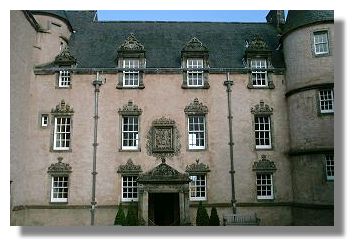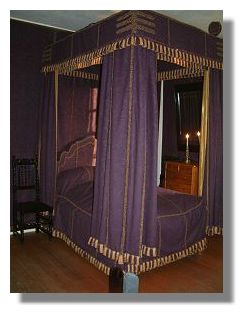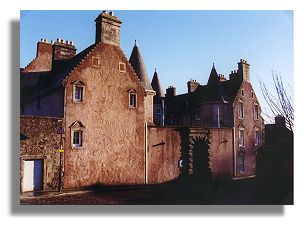
Places to Visit in Scotland
- Argyll's Lodging, Stirling

From Stirling to Argyll
Although the Earls (later Dukes) of Argyll, the chiefs of the clan Campbell, had their centre of power in the west at Inveraray, they nevertheless established a number of homes in various parts of central Scotland, including Castle Campbell in Clackmannanshire. Since Stirling Castle was frequently a royal residence, it was convenient for noblemen to have residences close by and Argyll's Lodging stands on the approach road to Stirling Castle.
Being within the city walls of Stirling, there would be dwelling houses on the site of what is Argyll's lodgings from the earliest times but the oldest part of the building which can be identified is a rectangular house in the north-east corner of the existing building which dates from the 16th century. Gradually this was added to and in 1629 new owner at that time, Lord Stirling, considerably extended it. He created additional wings to create a building on three sides of an internal courtyard with a screen wall facing onto Castle Wynd. Lord Stirling (Sir William Alexander) was a wheeler and dealer of his day and was made Viscount Canada by King Charles I but died insolvent.
Archibald Campbell, ninth Earl of Argyll acquired the property in the mid-1660s. His father had Covenanting sympathies and became a supporter of Cromwell - for which he paid with his life after King Charles II returned to the throne. Despite (or because of) his father's fate, Archibald was a supporter of King Charles II and as a result had his family estates and earldom restored to him. It is thought that the Earl of Argyll set about extending his Stirling residence because there was a possibility of the king paying a royal visit to Stirling.
The Finest Surviving 17th Century Scottish Town House
Architectural experts describe Argyll's Lodging as the finest and most complete surviving 17th century town house in Scotland. The building is now administered by the government agency, Historic Scotland. With a few brilliant exceptions (such as Edinburgh Castle and Stirling Castle, the properties looked after by Historic Scotland are usually ruins with little in the way of furniture and fittings. It is therefore a pleasant surprise to find the apartments in Argyll's Lodging refurnished, as they might have appeared around 1680 when Earl of Argyll owned it. And, unlike the National Trust for Scotland which prohibits photography inside all its properties, Historic Scotland has no such restriction. The drawing room (seen here) is particularly lavishly furnished, with tapestries lining the walls. This "state apartment" would have been used for his own meals and for entertaining distinguished guests.
For larger dinner parties the Earl would have entertained his guests in the high dining room (seen in the illustration) with a blazing log fire with a richly carved surround to keep everyone warm. If the table looks a bit like a modern "flat pack" style, this is because they would have been folded and placed round the walls when not in use as the space would also be used as a reception room on formal occasions when dining was not involved.

The bedroom used by the Earl and Countess of Argyll has a huge four-poster bed, draped in purple cloth matching the wall hangings. In the 17th century, this was often the most expensive item of furniture in an aristocrat's house. On occasions, the Earl may have received favoured guests while sitting up in bed - a sign of haughty condescension, which would allow him to show off his expensive furniture!There are a number of doors in the bedroom, with one leading to an "en suite" closet and another onto a spiral staircase, which was used by servants to gain access without having to pass through the public areas. But with no central heating and ill-fitting doors, movable screens would have been placed across the doors to cut down on the draughts.
How to Get There

Argyll's Lodging is on Castle Wynd near the centre of Stirling and is on the right-hand side as you follow the signs to Stirling Castle. See also the Scenic Map of Stirling.
Return to Index of Places to Visit
Where else would you like to go in Scotland?

